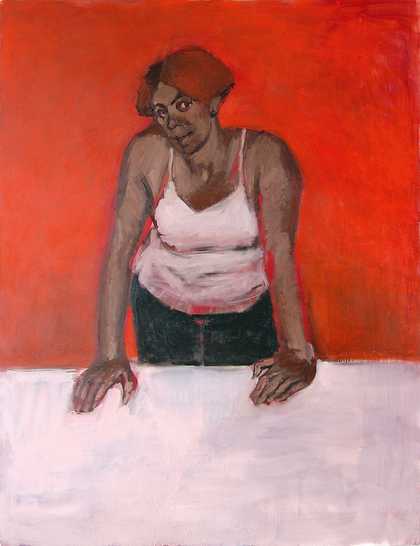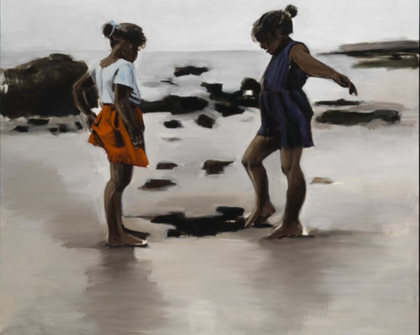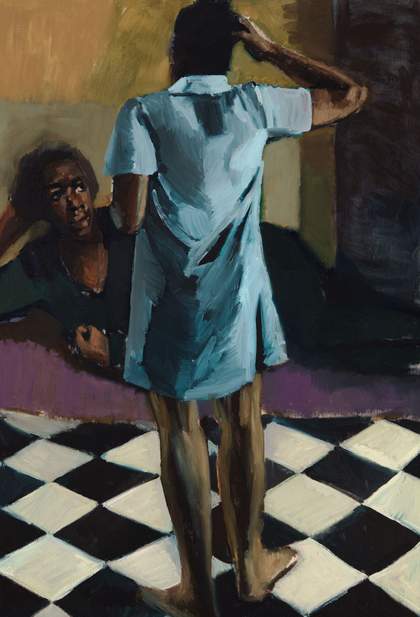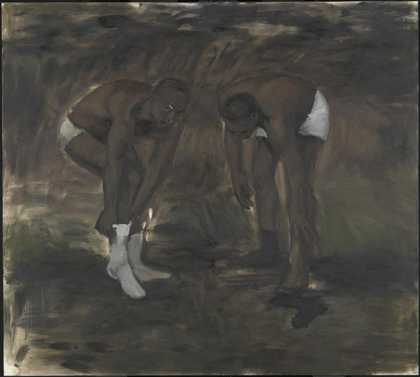
Lynette Yiadom-Boakye Any Number Of Preoccupations 2010
Oil paint on canvas 152 × 203 cm
Lynette Yiadom-Boakye, courtesy the artist, Corvi-Mora, London and Jack Shainman Gallery, New York. Dr Kenneth Montague / The Wedge Collection, Toronto
We stand before each other and look. Who are you? What do we see in each other? Perhaps our eyes meet this first time. Perhaps we tilt to the side, resist directness. We make a first assessment. Then we keep looking, and more is revealed in every glance, tilt, moment, and we come deeper into knowing.
Each Lynette Yiadom-Boakye painting is like looking into a story or an entire life. They call to mind vignette poetry collections such as Sherwood Anderson’s Winesburg, Ohio (1919), Jean Toomer’s Cane (1923), and Philip Larkin’s collection The Whitsun Weddings (1964), wherein poems like ‘Mr Bleaney’ imagine all that is behind the faces of the sometimes lonely people we see in our day to day, if we pause to look and consider. There are entire lives inside one frame, one poem, entire souls and stories inside the singletons and groups in these paintings.
The poem that most richly reminds me of the human worlds Yiadom-Boakye creates is Gwendolyn Brooks’s ‘The Bean Eaters’ of 1960:
They eat beans mostly, this old yellow pair.
Dinner is a casual affair.
Plain chipware on a plain and creaking wood,
Tin flatware.Two who are Mostly Good.
Two who have lived their day,
But keep on putting on their clothes
And putting things away.And remembering …
Remembering, with twinklings and twinges,
As they lean over the beans in their rented back room
that is full of beads and receipts and dolls and cloths,
tobacco crumbs, vases and fringes.

Lynette Yiadom-Boakye Diplomacy I 2009
Oil paint on canvas 190 × 250 cm
© Lynette Yiadom-Boakye, courtesy the artist, Corvi-Mora, London and Jack Shainman Gallery, New York. Pascale Revert
Brooks paints a first portrait of ‘this old yellow pair’, and we observe them in their intimate space. As in Yiadom-Boakye’s work, we have been invited into the middle of an intimacy, an interior moment. In the last stanza, propelled by the phrase ‘And remembering’ – pressed forward by the ellipses – Brooks takes us to a blossoming interior world ‘full of beans and receipts and dolls and cloths, tobacco crumbs, vases and fringes’. Specific, minute, infinite details live behind the tableaux. So too in these paintings, where complex selves full of memories, stories, places, intimacies and intricacies seem to live inside the depth of the frames.
Yiadom-Boakye’s evocative titles – her poet’s hand – set us off course into the elliptical of complicated lives. For a portrait we might expect a single name, answering who it is or what is the archetype. Instead, the painting that could be described as ‘Young Man in Blue’ is named the enigmatic Fiscal Playsuit. A painting that might simply be named ‘Funeral’ is, more richly, Diplomacy I, for of course funerals and death rituals are the ultimate site of cultural conflict. The painting makes that visible. ‘Three Figures at the Beach’? Hard Wet Epic. ‘Woman with Red Background’? Geranium Love Sonnet. ‘Man in Red Robe’? Ah, Any Number Of Preoccupations. And what might we imagine when we look at a painting that is called, not ‘Man in Pink Tie with Three Men’ but rather, An Education? Who is learning; who is teaching; who is learning what? The exercise is exhilarating, finding all that her titles evoke beneath the paintings, the not-visible and unspoken inside the depths.
Yiadom-Boakye is herself a poet and says she paints what she cannot write and writes what she cannot paint. I feel the limitations of words daily, and the limitation of the shapes that writing seems sometimes to offer. I wish I had more expressive latitude and invention when I face the page and experience what Audre Lorde describes: ‘Some words/bedevil me’.
But wrestling to make even an imperfect poem gets the poet closer to the self and thus to others, through the darkness. Yiadom-Boakye’s paintings reveal how the oblique angles of the self and meaning touch where human exchange is imminent. This poem of mine stands to face these paintings, at an angle. It begins as a portrait (after Yiadom-Boakye) of my late grandmother, and then imagines her in a place she never was: a poetry workshop.
Wenonah Bond Logan at the Poetry Workshop
Her verse is unsentimental and formal.
Her poem is perfectly typed on bond.
At the bottom she’s signed her name in curly script.
She waits her turn, accepts constructive criticism.
Her lines are well-turned, but what is imagined
is somewhere deep in the mangrove roots
that float in the brackish water beneath
her stanzas, oscillate, shimmy.There is no first-person in her poems,
no evidence who the words came from.
The words are Latinate. There is order.
There is beauty. Not wild beauty but beauty
like a well-made bed, a cup of coffee
creamed to the same shade as her skin, a tea
sandwich with the crusts cut off, a cardigan
folded neatly with tissue paper. Yes,these things are beautiful. The other part lives
neither in poems nor in her ablutions.
It wishes to wear shantung. It does not
wear a girdle, nor own hair rollers nor
rain bonnet, nor furniture on casters,
does not keep records on index cards.
Even when invisible it is there.
Inside the order is always something wild.
Is what the poem or the painting gives us the surface fantasy or fact? Known or imagined? Does it matter as long as the work of art takes us to somewhere human and true?

Lynette Yiadom-Boakye Geranium Love Sonnet 2010
Oil paint on canvas
180 × 140 cm
© Lynette Yiadom-Boakye, courtesy the artist, Corvi-Mora, London and Jack Shainman Gallery, New York. Collection of David Madee
With any writer or painter of the African diaspora, I think the ocean is somewhere in their work, even if it is not a subject. The ocean is the bottom, the ur-text, ground zero, the things that we crossed with something to carry, the void across which we have made something new despite the odds. It is the darkness wherein we perished, the nightmare from which we have not yet awakened. If a subject or not, the ocean, the middle passage, that blackness, is always there, I feel. These paintings – I wrote ‘these poems’, at first! – are not history-minded, so they are not of the ocean in that regard. They are of the ocean in her deep understanding of darkness, danger, mystery and colour.
When I think about the ocean and its traces in Yiadom-Boakye’s work, it is in her understanding of colour. The ocean, in its depths, is so, so dark. Her atmospheres are ocean dark. She is an oceanic painter. The impenetrable dark, the depths, all that water holds is mirrored in all her paint holds. The paradoxically full darkness of her paintings makes you look harder to see if you are missing something. What is hiding within the saturated depths?
And then, like waves that lift us and reveal colour, so too flashes of colour in the skirts of these paintings show themselves and this is extraordinary. So the impassable is in fact revelatory. There is something beneath. It is light, colour, surprise. Revelation. Colour, flashes of colour, are not necessarily more telling or informational than the dark in her paintings.
And I think of the deep understanding of human exchange, as well as all we never understand about each other. No matter how deep our intimacy, we are still vastly unknowable to each other. I have wished, with loved ones, to be inside of them, to know all that they think, to possess their memories, to see through their eyes. I have wished to step into their pelts and walk as they do. I have wished sometimes to grab them with my teeth by the scruffs of their necks – children, lovers, the best of friends – and carry them to the cave of mutual understanding. Intimacy is that animal and intense. The fascination as well as the vexation of intimacy is that we can never, truly, know each other completely.
Yet the light that insists its way through darkness is our human bond. Lucille Clifton: ‘the light insists on itself in the world’. It is miraculous, given all that shrouds us, that we come close together as often as we do. Lynette Yiadom-Boakye’s paintings believe in and make available that indelible truth. We may sometimes struggle to see each other, to come near each other. We may stand in close proximity and look directly at each other, as her paintings invite, but it takes several passes, several exchanges, the passage of time, to actually see and know each other more deeply.
These paintings make you want to stand in front of them again and again and return to the souls residing within. The bottomlessness of these paintings is like the bottomlessness of intimacy.
Lynette Yiadom-Boakye: Fly In League With The Night, Tate Britain, extended until 31 May, returning November 2022 – February 2023. Supported by Denise Coates Foundation, with additional support from the Lynette Yiadom-Boakye Exhibition Supporters Circle, Tate Americas Foundation, Tate International Council, Tate Patrons and Tate Members.
This essay is excerpted from Lynette Yiadom-Boakye: Fly In League With The Night, published by Tate Publishing, 2020. ‘Inside the Order Is Always Something Wild’ © Elizabeth Alexander 2020. ‘The Bean Eaters’ by Gwendolyn Brooks is reprinted by consent of Brooks Permissions.
Elizabeth Alexander is a poet, educator, memoirist and cultural advocate who has served as president of the Andrew W. Mellon Foundation since 2018 and is a two-time finalist for the Pulitzer Prize.



